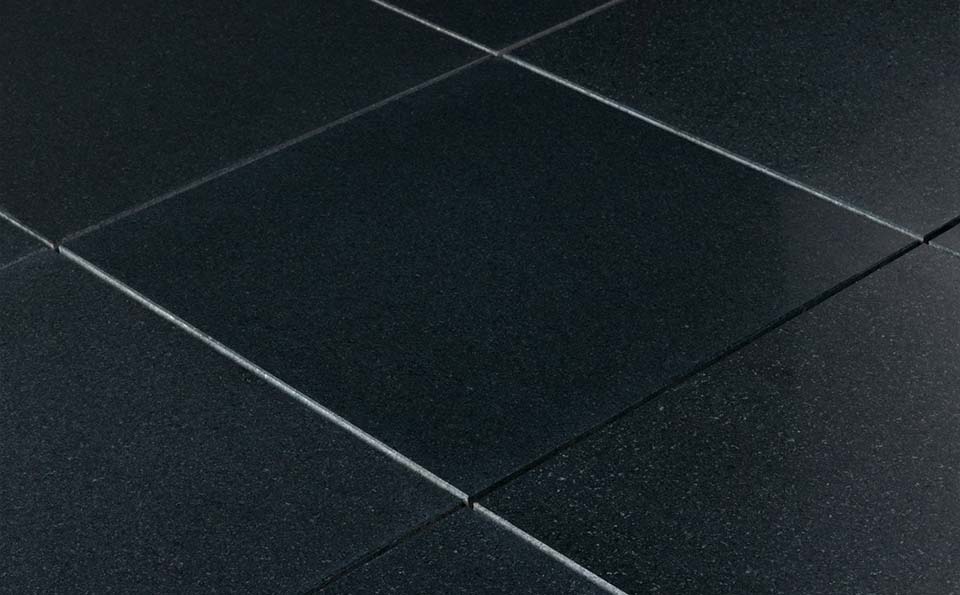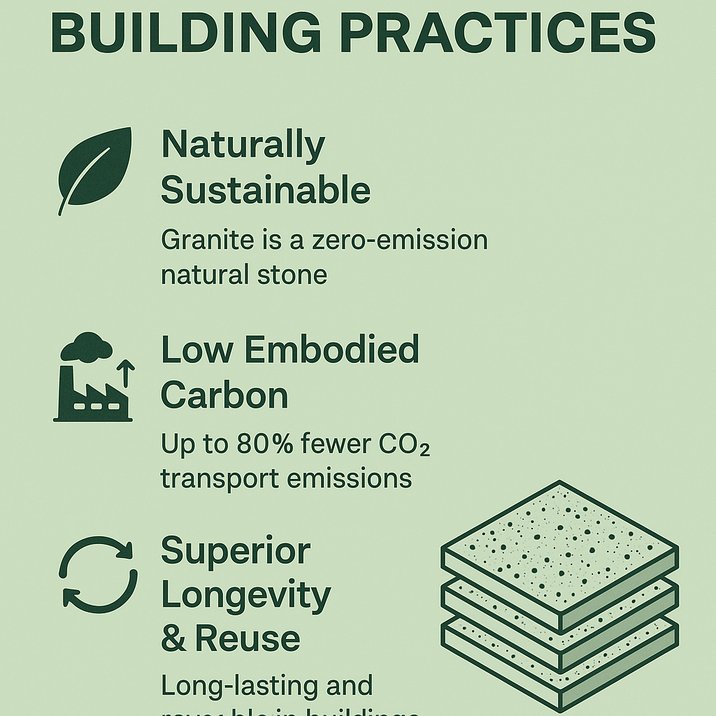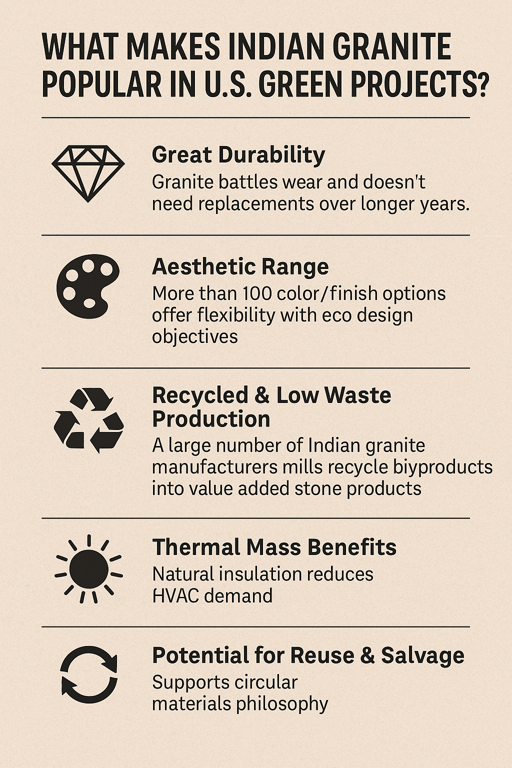In the world of sustainable architecture, nothing can beat the dexterity of natural stone. In recent times, Indian granite tiles have become a proven construction material in the U.S. green‑building domain— giving awesome visuals, durability, and environmental sustainability. Below is a post that carves out a strong footprint in sustainable architectural design.

The Green Building Wave in the U.S.
The U.S. green‑building materials market size was USD 88.2billion in 2022 and is expected to reach USD 235.18billion by 2030, with a CAGR of 12.7%. Regulatory requirements driven by climate, a desire to achieve certification through LEED standards and growing consumer interest in eco‑friendly spaces are some of the factors driving that growth. That surge spotlights flooring and interior finishes — where granite tiles shine.
Granite’s Global Growth
The global granite tile market was worth USD10.11billion in 2024 and will reach USD16.65billion by 2033 with a CAGR 4.0% %. The wider natural‑stone market (granite, marble, etc.) was valued at USD62.8billion in 2023, and by 2033 this is forecast to exceed USD105billion (Source ‐ DataHorizzon Research). Sustainable use of granite tile is one of the most important aspects of residential and commercial construction demand.
India’s Granite Advantage
India is endowed with granite resources with estimates of around 37.4billion m 3 constituting one of the largest in the world. It is also responsible for more than 20% of the world’s granite supply. There are over 250 shades and finishes from Indian quarries, providing a range of aesthetics without making extraction methods too expensive.
4. Why Indian Granite Tiles Fit Green Building Practices
Naturally Sustainable
Granite is a zero-emission natural stone, a product of nature, and does not emit harmful substances directly to the environment; 2, according to the ASTM standard, the sustainable material is theoretically qualified: low hazards (less pollution), greenhouse gas emissions are only produced in production And close to the infinite use value. It also has much lower embodied energy in comparison to artificial composites and ceramic tiles.
Low Embodied Carbon
Studies demonstrate that securing natural stone locally — preferably within 500 miles — translates to up to 80 percent fewer CO₂ transport emissions, roughly 2.7 fewer tons of CO₂ per average job, when compared to imported products. Although Indian granite is imported into the U.S., its long life and longevity of use amortize its carbon footprint over decades.

Superior Longevity & Reuse
Indian granite’s unmatched hardness and resistance to scratches, stains, and weathering simply means architectural installations that can endure generations. When buildings are refurbished or demolished, granite slabs and tiles are often completely reusable or recyclable, resulting in lesser landfill waste.
Strong Performance Meets Eco‑Credibility
Architects and designers are attracted to Indian granite for its performance and sustainability. The flexibility of color palettes and natural veining are attractive to customited design features,and its thermal mass helps balance indoor temperatures — reducing energy consumption over the long haul. These attributes are frequently awarded LEED points, particularly when low‑VOC finishes, as well as responsibly sourced materials, are identified in the specifications.
Indian Granite Tilted Toward Sustainability
A number of Indian producers have adopted waste‑efficiency strategies, including repurposing the granite “fines” (the dust and tiny pieces) for composite products and industrial by‑products like building blocks or terrazzo mixes. They cut down on possible waste from processable materials and improve eco-validation.
U.S. Trends: The Demand for Natural Stone Flooring on the Rise
In the US countertops & flooring market (valued USD7.4bn in 2023), natural stones are taking off, increasing due to eco‑awareness and investment value over years. Likewise, US green building materials flooring category is anticipated to experience rapid growth on account of LEED initiatives and focus on sustainable sourcing.

What Makes Indian Granite Popular in U.S. Green Projects?
Great Durability: Granite battles wear and doesn’t need replacements over longer years.
Aesthetic Range: More than 100 color/finish options offer flexibility with eco‑design objectives.
Recycled & Low‑Waste Production: A large number of Indian granite manufacturers mills recycle byproducts into value‑added stone products.
Thermal Mass Benefits: Natural insulation reduces HVAC demand.
Potential for Reuse & Salvage: Supports spherical materials philosophy.
Alignment with LEED / WELL Goals: Contributes to credits via responsible sourcing, durability, and indoor environmental quality.
Numbers That Drive the Point Home
Metric | Value |
U.S. green building materials market (2022) | USD 88.2 billion; CAGR 12.7% |
Global granite tile market (2024) | USD 10.11 billion |
Projected granite tiles market (2033) | USD 16.65 billion; CAGR 4.0% |
Global natural‑stone market (2023) | USD 62.8 billion; projected USD 105 billion by 2033 |
India’s share of world granite resources | Over 20%; reserves ~37.4 billion m³ |
CO₂ emissions reduction via local stone sourcing | Up to 80% less; ~2.7 tons less CO₂ per project |
These figures highlight the increasing junction of environmental consciousness and natural stone usage in high-valued construction projects in the USA.
How Developers & Architects Can Utilize Indian Granite Tiles
- Postulate responsibly sourced Indian granite that has traceability (factory-to-factory transparency)
- Use life‑cycle assessments to analyze embodied carbon vs. other options
- Incorporate granite fines byproducts, terrazzo combinations, or engineered stone variants
- Request recycled packaging and shipping via eco‑certified freight service providers
Final Thoughts: Indian Granite as a Sustainable Stone Standard
At a time when builders, specifiers and corporate real estate developers are challenged as never before to deliver greener, healthier and more enduring spaces, Italian marble floors and Indian granite tiles are the solution. They deliver unparalleled strength, low lifecycle environmental impact, and design flexibility – while supporting the circular economy and low-carbon construction trends around the world.
As the U.S.’s green‑building industry continues to grow—propelled by increasing regulation, consumer demand, and LEED goals—Indian granite is not simply an upscale choice, but a strategic, sustainable material that will pay off down the line.
If you’re an architect, developer, or design professional exploring certified Indian granite tiles that can enhance the sustainability of your next project, there are many reliable Indian granite tile manufacturers & exporters ready to serve you.
